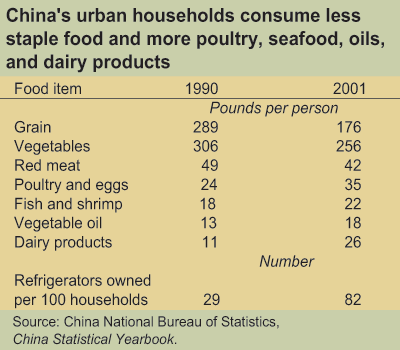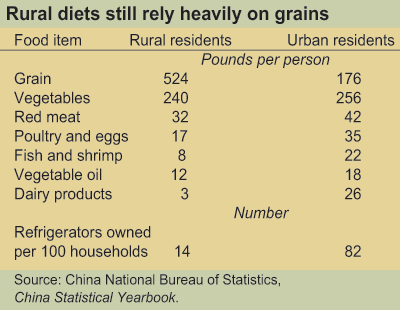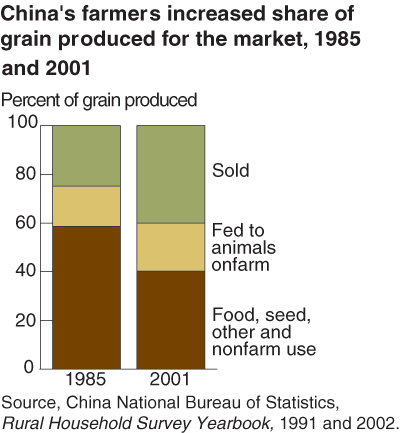China’s Growing Affluence: How Food Markets are Responding
- by Fred Gale
- 6/1/2003
The proliferation in China of restaurants, supermarkets, advertising, new products, and attractively packaged goods signals Chinese consumers’ new, more prominent influence in their country’s economy. The increased spending power and changing eating habits of China’s 1.3 billion people are transforming the country’s food sector, both domestically and in foreign trade. In the past decade, China’s agricultural imports have diversified to include more meats, vegetables, seafood, processed foods, and other consumer-oriented products, and China’s rising consumption of edible oils has made it a $2-billion-per-year importer of soybeans. Foreign firms are playing a leading role in China’s fast-developing fast food and food retail sectors, and foreign products can now be found on the shelves of Chinese supermarkets. Farmers and agricultural- and food-related businesses that can keep up with the rapid pace of change will be the best prepared to make further inroads in the China market.
Changing Food Landscape
The way Chinese people buy and consume foods has been transformed since of the early 1990s. Brightly lit supermarkets with computerized checkouts are staffed by crisply uniformed attendants. Numerous brands of rice and cooking oil packaged in attractive bags and plastic bottles vie for the attention of shoppers. Fast food and full-service restaurants and shopping mall food courts have proliferated, as have foreign brand names on restaurant signs and supermarket shelves. Dimly lit government-run grain stores are a thing of the past, and ration coupons have been relegated to collector’s items.
Open-air farmers’ markets still offer city residents fresh vegetables, fruits, eggs, and meat, but these traditional food outlets, too, have changed: fewer market vendors sell produce they grow themselves. Instead, many vendors sell fruits and vegetables bought from large wholesale markets or other middlemen. During the winter, markets sell fresh fruits and vegetables grown in greenhouses or trucked in from southern provinces.
Under strict central planning (1958-78), consumption in China took a back seat to production and investment. Salaries and living standards were uniformly low, and Chinese officials sought only to ensure that the basic food needs of the population were satisfied.
Since embarking on market-oriented reforms in the 1980s, however, China has seen incomes and living standards rise. In the food sector, government planning has given way to markets and private enterprises intent on satisfying the increasingly discerning and sophisticated tastes of Chinese consumers. Other early reforms focused on production—allowing farmers and factory managers to pursue profits instead of government plans. In the 1990s, as the influence of government planners receded and it became clear that there would be no retreat from market-oriented reforms, China’s consumer-oriented economy blossomed, opening the door for manufacturing, retail, and service industries.
China’s increasingly affluent consumers are demanding a wider variety of food products, more processed food, and more convenient food. They are broadening their diets to include more poultry, eggs, dairy products, fish, and refined vegetable oils. Their diets now include smaller proportions of traditional staples—rice, wheat, vegetables, and pork. The result is a booming and rapidly changing food sector. Food manufacturing firms are growing, introducing new products, investing in modern equipment, and addressing food safety issues. Food retailing is moving from traditional farmers’ markets and corner kiosks to modern “hypermarkets,” convenience stores, and fast food restaurants. With an eye toward efficiency, transportation, storage facilities, and distribution channels are being upgraded to accommodate the commercialization of the food sector.
More Choices for Consumers
The transformation of China’s rice market typifies many of the changes occurring in China’s food sector. Until the 1990s, urban Chinese consumers purchased generic rice at set prices from government-run grain shops. Rice was usually procured by government authorities from local farmers, who tended to offer the government their lowest quality product. Rice was often broken and unpolished, and stones and other foreign material were often mixed in with the grain.
Today, China’s rice industry is highly competitive, and rice is no longer a generic commodity. Consumers can choose among numerous brands differentiated by type, quality, and origin, and prices reflect rice attributes and quality. For example, in Beijing supermarkets, japonica (short-to-medium-grain) rice brands associated with distant counties in northeastern provinces fetch premium prices because they have a reputation for high quality.
Chinese consumers’ preferences for rice varieties tend to vary regionally, with differences based on rice attributes, including taste, texture, size of grain, stickiness, and cooking characteristics. Rice from counties known for high-quality japonica rice is prized in northern China and has been traditionally shunned by southern Chinese, who prefer long-grained indica rice. Now, however, japonica rice is widely consumed in wealthy southern areas, such as Shanghai and Zhejiang province. The availability of japonica rice in Shanghai illustrates how food markets are becoming national in scope, rather than local, as regional differences in tastes and preferences erode.
Environmental and safety concerns are also beginning to play a role in food consumption and production. Many brands of northeastern japonica rice now display the government-designated “green food” seal, which certifies low use of chemicals and a relatively pollution-free production environment. China’s Ministry of Agriculture has aggressively promoted the green food program to address concerns about excessive chemical use in China’s food supply and build a reputation in world markets as a source of safe produce. Consumers are becoming aware of biotechnology issues in food production, and new labeling regulations for foods containing genetically modified organisms were issued in 2001. In recent years, a number of widely publicized incidences of deaths and illnesses caused by foodborne pathogens have raised concerns about food safety standards and their enforcement.
Urbanization Separates Producers and Consumers
Until recent years, Chinese consumers and farmers were, for the most part, one and the same. In 1990, some 70 percent of the population were farmers, and Chinese farmers grew food largely for themselves. Farms needed to market only a small portion of their production to feed the relatively small urban population.
Rural-urban migration and growth in nonfarm employment opportunities have reduced the share of China’s population living on farms. Estimates of China’s farm population vary widely, but farmers now probably make up about half of the country’s population. Thus, more people are buying their food instead of growing it themselves.
Rice industry experts in China say that rural-urban migration has helped raise demand for japonica rice. Wheat is the staple crop for farm households in the north China plain region. For example, rural people in the northern province of Shandong consume an average of 419 pounds of wheat annually and only 11 pounds of rice. The national average for urban residents is about 53 pounds of wheat products and 101 pounds of rice. When farmers take up nonfarm jobs in northern cities, they increase their consumption of rice—usually japonica rice produced in northeastern provinces—and reduce their consumption of wheat.
The striking difference between rural and urban food consumption patterns suggests that continued urbanization will significantly alter the structure of food demand in China. On a per capita basis, rural residents consume about three times as much grain per capita as do urban residents, but urban residents consume more of everything else. Urban households are much more likely than rural households to own refrigerators, increasing their ability to purchase perishable, chilled, and frozen foods.
Subsistence Gives Way to Commercial Farming
The commercialization of China’s food sector has also triggered a gradual transformation of the country’s subsistence farms. In 1985, for example, Chinese farms sold just 25 percent of the grain they produced and consumed 75 percent onfarm as food, animal feed, or seed. By 2001, farms were selling 40 percent of their grain.
While many of China’s farmers recognize the opportunities presented by consumer-driven agriculture, great challenges remain in commercializing the country’s vast farm sector. China has some 200 million farms, averaging just 1.6 acres of cropland per farm. The country’s collective land ownership bans land sales and makes it difficult for farmers to rent land, presenting an obstacle to increasing farm size and investing in mechanized equipment. The small scale and large number of Chinese farms makes it seemingly impossible to organize, monitor, and standardize the quality of products. Conflicts have arisen as suppliers to food retail and restaurant chains have begun contracting with Chinese farmers unaccustomed to producing goods to such exacting standards. For example, suppliers to foreign fast food chains selling french fries have had difficulty procuring potatoes meeting the chains’ quality standards. Suppliers to supermarkets must procure goods that meet standards for size, quality, color, and chemical residues. The large number of small farmers in China makes it difficult to monitor chemical and seed use to enforce green food standards, ensure sanitation in slaughter of livestock, and certify nongenetically modified food products.
Since the mid-1990s, Chinese agriculture officials have promoted a “companies leading households” strategy to bring farmers into the commercial food sector and raise their incomes. This strategy emphasizes links between farmers and processing and marketing companies to strengthen farmers’ connections with the market and to raise farm incomes.
“Dragon head” or “leading” companies are selected or established by government authorities in localities to contract with farmers to procure produce with specific attributes. The dragon head company provides seed, operating loans, fertilizer and other inputs, and technical expertise. The company mills or otherwise processes the raw materials and sells products under a brand name often associated with the locality. For example, dragon head companies mill and package the northeastern japonica rice brands found in Beijing supermarkets. The companies contract with farm households in villages and townships to procure specific japonica rice varieties at a premium over open-market prices.
On the surface, China’s “companies leading households” model resembles contract production common in U.S. agriculture. In the Chinese model, however, the government plays a much greater role. The ownership structure of China’s dragon head companies is not clear, but many seem to be spinoffs of local grain bureaus and other government marketing entities. Some are privately owned, and others are joint ventures with foreign companies. The government’s role may include ownership, direction, or provision of land, facilities, credit, or subsidies. Management decisions seem to reflect government plans to develop particular sectors, sometimes resulting in overcapacity. Thus, while China’s food sector appears to be privatized, the government still wields a heavy influence.
Greater Trade Opportunities
Thus far, the changes sweeping across China’s food sector have had a modest but growing impact on U.S. exports. Some U.S. chains, such as Kentucky Fried Chicken, McDonald’s, Pizza Hut, and Wal-Mart, have expanded rapidly in China, but they procure most of their raw materials locally. Foreign brands of soft drinks, yogurt, sausage, potato chips, breakfast cereals, jellies, wine, and other foods and beverages comprise about 5 percent of products in Chinese supermarkets, but many of those products are also manufactured with local ingredients.
In some cases, however, the combination of growing demand and tariff reductions has boosted China’s imports of foods and food ingredients. The most notable example is soybeans—now the largest U.S. agricultural export to China at $1 billion per year. Growth in China’s soybean imports was partly stimulated by increasing demand for refined cooking oil. Concurrently, demand increased for soybean meal used in high-protein animal feeds to satisfy growing consumer preferences for poultry, fish, and red meat. Imported apples, grapes, citrus, seafood, dairy products, chicken feet, other cuts of meat, wine, and specialty vegetables are also becoming more common in China, although they are still mostly limited to high-end supermarkets, restaurants, and hotels in the largest cities. The United States has historically exported primarily bulk agricultural commodities to China, but exports of consumer-oriented food items have grown from insignificant amounts in the early 1990s to nearly $300 million during 2002.
At the same time, U.S. farmers are facing greater competition from China in the world market. China is raising quality and safety standards, learning more about the world market, improving its marketing system, and becoming more competitive in many food sectors. During the 1990s, Japanese trading companies developed vegetable, mushroom, garlic, and poultry production bases in eastern China for exports to Japan. China’s surging exports of fresh vegetables could pose a threat to the large U.S. share of Japan’s vegetable market. South Korean and Japanese companies have entered into joint ventures with northeastern dragon head companies to develop rice varieties suitable to tastes in their home markets. They have improved milling quality by equipping mills with world-class Japanese and Swiss machinery. China’s share of the Japanese rice market more than doubled from 8 to 18 percent between 1995 and 2001.
Clearly, the commercialization of China’s food sector is an important development. Changes in the organization and structure of agricultural production, food processing, and food distribution in China are transforming agricultural trade of the world’s largest agricultural country. The vast size of the Chinese market offers opportunities for foreign companies but could also give Chinese agribusiness companies a platform to develop into major competitors in world food-related markets.





